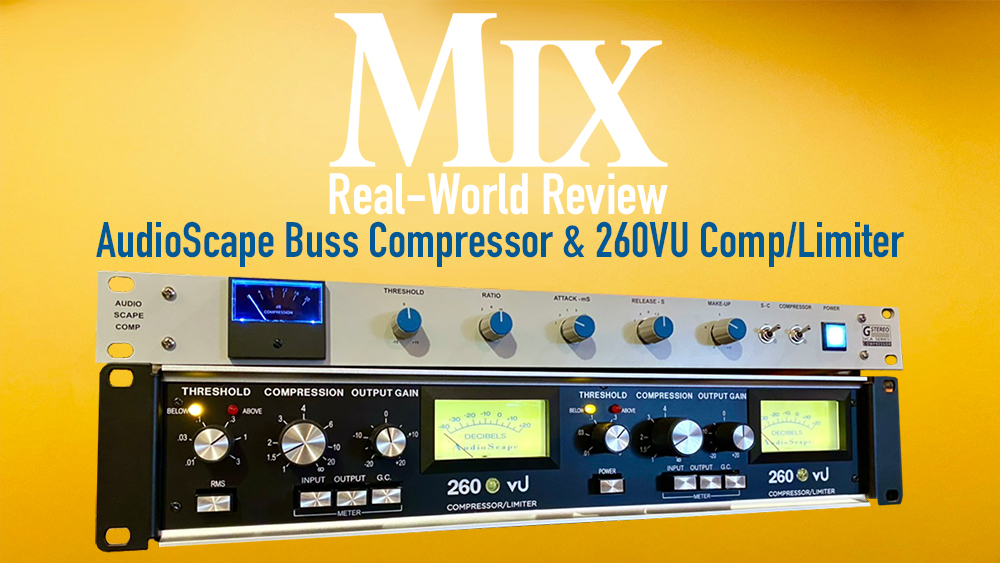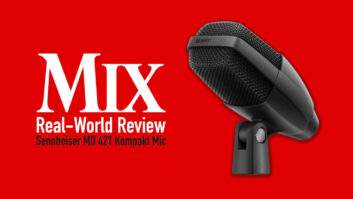
New York, NY (February 15, 2024)—You may have noticed that clones are all the rage these days, as it seems that today’s engineers feel a need to add a few pieces of choice analog hardware to their otherwise digital rigs. The new stereo Buss Compressor from boutique U.S. manufacturer AudioScape—where they make hardware by hand, with each specialized craftsperson working on no more than two models in their line—is an example of how classic sonics are being brought into the present for affordable prices.
The Buss Compressor re-creates the classic SSL center-section, quad-VCA compressor, known for great mix cohesion, minimal distortion and plenty of punch. The look is right on-point with the classic cream color, blue Sifam knobs, single VU meter, classic backlit square power button and minimalist graphics. More importantly, THAT Corp. VCAs do the heavy lifting, Neutrik connectors are at the I/O points, Alpha pots and switches are used throughout, and an Antek power supply (120 or 240 V) provides the juice.
The controls are faithfully accurate, save one new addition. There’s an In/Out switch, a continuously variable Threshold control, Ratio (2, 4 and 10:1 only), Attack (six settings, including a super-fast 0.1 millisecond), Release (five settings, including Auto, which I tended to use the most) and Make-Up (gain, that is, from -5 to +15 dB).
The new feature is an entirely welcome one: a side-chain high-pass filter that engages a 160 Hz filter on the side-chain detection circuit, stopping bass-heavy material from excessively triggering compression or causing pumping. That side-chain circuit is in stereo, just like the original.
I tried the BC on all the typical apps that you would pick a stereo VCA comp for and got what I’d consider predictable results—it sounded great and got the job done without calling any attention to itself or adding color.
Drum overheads sounded sweet, with a nice big stereo image, the side-chain filter preventing pumping and the VCAs working transparently.
Insertion on a drum subgroup/bus dealt similar results, with plenty of punch and energy. Piano, acoustic guitar and synths all filled-up and rounded-out nicely as they oughta. Of course, I tried whole mixes too, where the auto release was welcome; 4:1 works pretty well if you’re careful with threshold and release, and the stereo image stayed wide and large.
I’m not sure how they make these by hand in the USA for only $799 (direct), but they do, and they offer a healthy two-year warranty to boot. I was a little skeptical at first, but the Buss Compressor sounds extremely close to the original inspiration, is built with ample attention to detail and is an attractive bargain.
Dear Reality Exoverb Stereo Reverb Plug-In — A Mix Real-World Review
The other review unit—the 260VU Compressor/Limiter—took me way back to my early days of studio work, when every room I worked in had dbx compressors; the big rooms, the semi-pro studios, my studio—we all had 160s, 162s, 165s, 165As and those quirky, one-slider 163s, too. I have to admit it strikes a warm spot in my heart to see the new AudioScape 260VU, especially at $1,499 direct. It’s a beautifully exacting re-creation of those seminal 1970s stalwarts—the only one on the market— with VCAs, a feed-forward design, the glossy black front plates, silver knobs and the classy aluminum edge trims.
The 260VU front panel houses a pair of VUs, of course, that indicate either input level, output level or attenuation, as selected by that familiar row of three mutually exclusive pushbuttons.
The Threshold control is accompanied by two LEDs, yellow for Below and red for Above. The Compression ratio is continuously variable from 1.5 to infinity:1. Output Gain ranges continuously from -20 to +20 dB. The RMS button allows linking of the side-chain detectors, enabling true stereo operation.
As with the Buss Compressor, I tried out all the usual suspects and once again got predictable results—in that the 260VU has an identifiable 160/162/165 vibe when the needle is just-a bobbing away, and is also unexpectedly versatile.
I had to start with bass for old time’s sake and the 260VU nailed it, with nice consistency and a growl-free, punchy tone. Veteran 160/162 users know how in the absence of attack/release controls, you fiddle with the threshold-to-ratio balance and often find unexpected settings that sound right even when they “shouldn’t.”
Kick and snare (in dual-mono mode) had that classic rock ’80s signature that’s still pretty cool, and vocals got a tonally familiar taming. I’m fond of using the 260 in tandem with another compressor, with the 260 doing the quick peaks and an opto doing the slower work. I used the 260 to finish-off a complex throwback ’80s goth vocal sound (pitched, stereo-ized, ’verbed and dirty) that was made steady and perfect by the 260’s subtle, old-school cues.
For those wishing to inject classic compression tones into their modern productions, plug-ins are a fine option—but if some actual knob twisting, a little extra mojo and analog hardware is your thing, give AudioScape a look. These two compressors measure up, sound authentic and come recommended.







